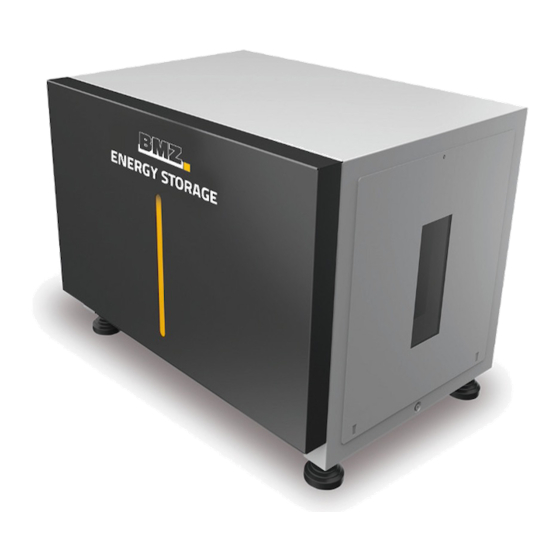
Table of Contents
Advertisement
Quick Links
Advertisement
Table of Contents

Summary of Contents for BMZ ESS
- Page 1 Troubleshooting Guide for BMZ ESS – Energy Storage System...
- Page 2 Service Phone: +49 6188 9956-9830 E-mail: ess.service@bmz-gmbh.de Document Version: 1.01 Identification Subject to modifications. BMZ shall not be liable for technical or editorial errors. Copyright All contents of this document are protected by copyright. © by BMZ USA, September 2020.
-
Page 3: Table Of Contents
Content Contents Safety Notes and Important Information Important information on this guide Expected Battery Operation Troubleshooting Steps and Information Battery does not turn on No voltage from the battery cables Battery Voltage Issues Inverter connected to battery will not turn on Service tool communication error or failure Battery has been working properly with inverter but has suddenly stopped working and turned off... -
Page 4: Safety Notes And Important Information
ESS 7.0, ESS 9.0, and ESS All the questions and information presented in this document represent items that have actually been asked by or clarified to users and installers of the BMZ ESS at some time in the past. Please ensure you have reviewed all information relevant to usage and operation of the battery and the safety information contained therein prior to conducting any troubleshooting exercise. -
Page 5: Troubleshooting Steps And Information
If the LEDs fail to light up after holding the switch down for a couple seconds, then the battery or one of its internal components has malfunctioned or failed. There could be several different causes for this and additional troubleshooting by BMZ will be required. Please contact BMZ. -
Page 6: No Voltage From The Battery Cables
If above is verified and tested and there is still an issue, this very likely indicates some internal issue. Please contact BMZ. Battery Voltage Issues There is always a very small drain on lithium batteries regardless of whether they are in use or not. -
Page 7: Inverter Connected To Battery Will Not Turn On
If you are unable to charge the battery yourself or it has passed the point of no return, please contact BMZ if you would like to purchase a replacement or send the battery for disposal. -
Page 8: Battery Has Been Working Properly With Inverter But Has Suddenly Stopped Working And Turned Off
2. Ensure your computer has the proper drivers. Sometimes a computer will need a driver update to allow the service tool to work. Please see the Service Tool Manual by BMZ for instructions on how to do this. 3. Try reinstalling the firmware. -
Page 9: Battery Temperature
The key caveat to the previous statements is that this range is outside the ESS operational range. Exposure to temperatures outside the ESS specified temperature range can cause degradation to the battery lifetime as well as possible triggering of battery protections which may require servicing. -
Page 10: Configuring Batteries In Parallel
Configuring Batteries in Parallel Normally, BMZ ESS batteries are plug and play. There are not many settings you can change on them. A. Once the batteries are all configured and connected in parallel and the system is running with the inverter, ensure that a discharge and charge cycle is completed. Afterwards, all batteries in parallel should be ON, relays closed, and voltage synced. -
Page 11: The Battery Soc Is Wrong
2.9.1 The Learning Cycle: All ESS batteries must go through a learning cycle. This calibrates the SOC and allows the battery to learn its real capacity (true of any battery on the market, the actual capacity versus the design capacity will vary a little) and become more efficient. -
Page 12: Off-Grid Systems, Battery Soc And Running Generators
2.11 Battery Capacity Issues BMZ ESS have both nominal and usable capacity listed in the product literature. For actual usage, usable capacity will always be the value used. 1. I get a lower amount of capacity from the battery than expected... -
Page 13: Dropped Batteries
This is a hazard. If you know an ESS has been dropped or think an ESS has been dropped or suffered other abuse due to observable bending of the metal frame/housing, do not use it. There is no way to recover a dropped battery and it will need to be scrapped. - Page 14 BMZ GmbH Am Sportplatz 28 - 30 63791 Karlstein am Main GERMANY Phone +49 6188 9956-0 +49 6188 9956-900 kontakt@bmz-gmbh.de www.bmz-gmbh.de ESS Troubleshooting Guide Page 2 of 14 Version 1.01...

Need help?
Do you have a question about the ESS and is the answer not in the manual?
Questions and answers